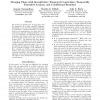Free Online Productivity Tools
i2Speak
i2Symbol
i2OCR
iTex2Img
iWeb2Print
iWeb2Shot
i2Type
iPdf2Split
iPdf2Merge
i2Bopomofo
i2Arabic
i2Style
i2Image
i2PDF
iLatex2Rtf
Sci2ools
AIPS
2000
2000
Merging Plans with Quantitative Temporal Constraints, Temporally Extended Actions, and Conditional Branches
We develop an algorithm for merging plans that are represented in a richly expressive language. Speci cally, weare concerned with plans that have i quantitative temporal constraints, ii actions that are not instantaneous, but rather have temporal extent, and iii conditional branches. Given a set S of such plans, our algorithm nds a set of constraints that jointly ensure that the plans in S are mutually consistent, if such a set of constraints exists. The algorithm has three phases. In the rst, it employs a new data structure, a conditional simple temporal network CSTN, to identify con icts between the plans. Next, it uses an approach developed by Yang 1997 to suggest a potential resolution of the identi ed conicts. Finally, the CSTN is again used to check whether the proposed resolution observes all the temporal constraints. We have implemented our approach, and we present preliminary experimental evidence about domain factors that in uence its performance.
AIPS 2000 | Algorithm | Artificial Intelligence | Quantitative Temporal Constraints | Temporal Constraints |
| Added | 01 Nov 2010 |
| Updated | 01 Nov 2010 |
| Type | Conference |
| Year | 2000 |
| Where | AIPS |
| Authors | Ioannis Tsamardinos, Martha E. Pollack, John F. Horty |
Comments (0)

